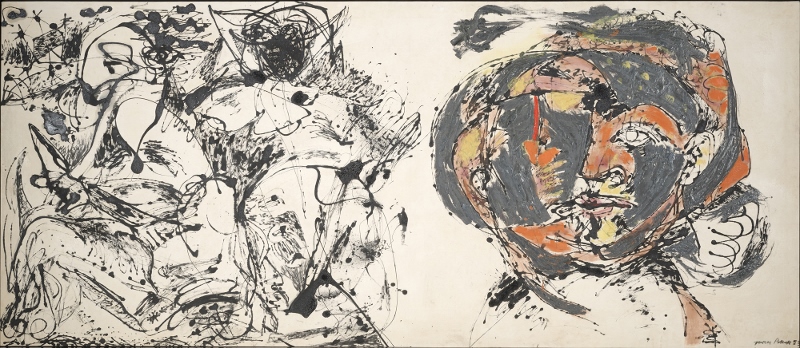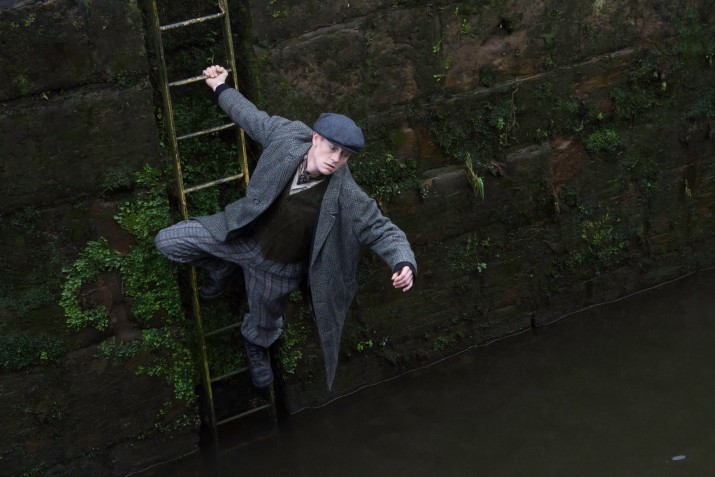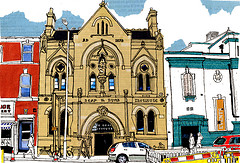Jackson Pollock’s black pourings weren’t popular during his lifetime. In fact, they’ve never had the attention that admirers think they deserve.
I guess there is an expectation that if you are a vivid artist, you serve to decorate and co-ordinate with furnishings first and foremost or you don’t sell – they are paintings after all; badges for walls.  But like his mentor Thomas Hart Benton whose popular shapely social realism was squeezed out in slivers of luxurious colours, Pollock was just as fond of showing what monochrome does to a subject.
But like his mentor Thomas Hart Benton whose popular shapely social realism was squeezed out in slivers of luxurious colours, Pollock was just as fond of showing what monochrome does to a subject.
Now Tate Liverpool has foraged the biggest collection of the black pourings, calling the exhibition Blind Spots because the paintings are thought to have been a blind spot in his career.
Pollock once said: “I’m very representational some of the time and a little all of the time.” Not having a net of Technicolor to fall back on, these black paintings allow us to see figures and objects and, as the texture bleeds or catches the light, they are more like sculptures than canvases. They are just as valid and fascinating as his better-known works.
I’m all about the blind spots – those nooks and crannies not usually considered important are your own secret delights, and when the powers that be take their eyes off the ball those blind spots are where great social change takes place.
So, Jackson Pollock: Blind Spots. I talked to assistant curator Stephanie Straine about the forthcoming exhibition, the importance of the black pourings, and Pollock’s legacy.
Cathy Crabb: Do you believe that the black pourings stand alone?
Stephanie Straine: Yes, I do. They are a compelling body of work which haven’t had enough attention paid to them in recent years. The black paintings from 1951 in particular form a complete unit of work – almost wholly monochromatic, and like enlarged drawings in enamel – they really demonstrate that Pollock was very deliberately changing his style and technique to confound those critics who believed he had reached a ‘dead end’ with his recent mural-scaled, all-over works.
CC: What does it mean to bring them together, why now?
 SS: The works from this period have often been overlooked in favour of the artist’s iconic drip paintings, which date from the years immediately before, 1947-50. Pollock is so often categorised as an abstract artist that I think these black paintings, in which representation returns to his work – such as faces, and writhing, part animal/part human bodies – were routinely misunderstood or left out of accounts of the artist’s work and career, as they complicate the story of him progressing towards complete abstraction. As ever, the truth is a little more complicated. As Pollock himself wrote to friends in 1951: “I’m very representational some of the time, and a little all of the time. But when you’re painting out of your unconscious, figures are bound to emerge…painting is a state of being.”
SS: The works from this period have often been overlooked in favour of the artist’s iconic drip paintings, which date from the years immediately before, 1947-50. Pollock is so often categorised as an abstract artist that I think these black paintings, in which representation returns to his work – such as faces, and writhing, part animal/part human bodies – were routinely misunderstood or left out of accounts of the artist’s work and career, as they complicate the story of him progressing towards complete abstraction. As ever, the truth is a little more complicated. As Pollock himself wrote to friends in 1951: “I’m very representational some of the time, and a little all of the time. But when you’re painting out of your unconscious, figures are bound to emerge…painting is a state of being.”
Now is a good time to bring these paintings to a wider audience because we are only just starting to understand the real legacy of these works. Many contemporary artists have cited them as an important precedent for bridging the divide between abstraction and figuration, and I think our audience in Liverpool will appreciate how much relevance they have to the state of contemporary art today.
CC: What has been the selection process for the black pourings? Was it the intention to bring as many as possible together?
SS: Research suggests there are approximately 40 black pourings and at Tate Liverpool we will show 21, ranging from circa 1950/51 to 1953 in date. The exhibition offers a unique opportunity to see the largest number of Pollock’s black pourings ever assembled in the UK, with some never before seen in this country.
CC: I see in 2D so paintings are only a step away from real life, my blind spot is where fact and fiction are blurred – rather like on the duck paper. For some, it is an oversight or an accidental mistake. What does it mean to you in terms of this exhibition?
 SS: I think your description of a blind spot being where fact and fiction are blurred is actually very apt in terms of the starting point from where we conceived this exhibition. There has been so much mythology built up around Pollock the artist (and the man) that in fact it is now very difficult to view his life and career objectively, and not be guided by the art-historical narrative that has been written in the past half century. Our argument is that his work as a sculptor, as a draughtsman, as a printmaker, and as a painter of representational imagery, has been somewhat accidentally overlooked, and we’d like to offer visitors a fresh take on these parts of his career.
SS: I think your description of a blind spot being where fact and fiction are blurred is actually very apt in terms of the starting point from where we conceived this exhibition. There has been so much mythology built up around Pollock the artist (and the man) that in fact it is now very difficult to view his life and career objectively, and not be guided by the art-historical narrative that has been written in the past half century. Our argument is that his work as a sculptor, as a draughtsman, as a printmaker, and as a painter of representational imagery, has been somewhat accidentally overlooked, and we’d like to offer visitors a fresh take on these parts of his career.
CC: It is interesting to see the difference in work later in an artist’s career. In particular I am thinking about the representational moments in the black pourings. Will we see that when they are alongside his better known pieces?
SS: This exhibition will take visitors on a journey through the artist’s career, from his iconic drip paintings from 1947–49 to the black pourings period, 1951-53. The point of this juxtaposition is to allow those more representational moments to be revealed as all the more daring and revolutionary when seen against what came before in Pollock’s practice. Exhibiting works from the peak of the artist’s fame alongside his lesser known work offers viewers the opportunity to appreciate Pollock’s broader ambitions as an artist and better understand the importance of the ‘blind spots’ in his practice.
By Cathy Crabb
Jackson Pollock: Blind Spots runs at Tate Liverpool from June 30 – October 18, 2015
www.tate.org.uk/whats-on/tate-liverpool/exhibition/jackson-pollock-blind-spots












